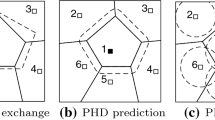Abstract
We describe a novel method whereby a particle filter is used to create a potential field for robot control without prior clustering. We show an application of this technique to control a team of mobile robots to cooperatively locate and track a moving target. The particle filter models a probability distribution over the estimated location of the target, providing robust tracking despite frequent target occlusion. This method extends previous work in particle-filter-based tracking in two important ways. First, the particle cloud is never clustered to find a single estimate of target location. Instead, robot motion is guided by a potential field generated directly from the particle cloud. Secondly, effective coordinated multi-robot searching and tracking can be achieved by simply assigning a subset of the particles to each robot.
Simulation trials and real robot experiments demonstrate the method successfully locating and tracking targets, and experiments show that multiple coordinated robots outperform a similar but uncoordinated team.
Similar content being viewed by others
References
Breazeal, C. (2003). Towards sociable robots. Robotics and Autonomous Systems, 42(3–4), 167–175.
Bruce, A., & Gordon, G. (2004). Better motion prediction for people-tracking. In IEEE international conference on robotics and automation.
Connolly, C., & Grupen, R. (1993) On the application of harmonic functions to robotics. Journal of Robotic Systems, 10(7), 931–946.
Daniel, W. W. (1978). Applied nonparametric statistics (p. 135). Boston: Houghton.
Efros, A. A., Berg, A. C., Mori, G., & Malik, J. (2003). Recognizing action at a distance. In Proceedings of the 9th international conference on computer vision (Vol. 2, pp. 726–733).
Fox, D., Ko, J., Konolige, K., Limketkai, B., Schulz, D., & Stewart, B. (2006). Distributed multi-robot exploration and mapping. In Proceedings of the IEEE.
Gerkey, B. P., Vaughan, R. T., Stoy, K., Howard, A., Sukhatme, G. S., & Matarić, M. J. (2001). Most valuable player: A robot device server for distributed control. In IEEE/RSJ international conference on intelligent robots and systems (pp. 1226–1231).
Gerkey, B. P., Thrun, S., & Gordon, G. (2004). Visibility-based pursuit-evasion with limited field of view. In Proceedings of the national conference on artificial intelligence (AAAI 2004) (pp. 20–27).
Howard, A., Matarić, M. J., & Sukhatme, G. S. (2002). Localization for mobile robot teams using maximum likelihood estimation. In IEEE/RSJ international conference on intelligent robots and systems (pp. 434–459).
Isard, M., & Blake, A. (1998). Condensation—conditional density propagation for visual tracking. International Journal on Computer Vision, 29(1), 5–28.
Jung, B., & Sukhatme, G. S. (2004). A generalized region-based approach for multi-target tracking in outdoor environments. In IEEE international conference on robotics and automation (pp. 2189–2195).
Khatib, O. (1986). Real-time obstacle avoidance for manipulators and mobile robots. International Journal of Robotics Research, 5(1), 90–98.
LaValle, S. M., Lin, D., Guibas, L. J., Latombe, J. -C., & Motwani, R. (1997). Finding an unpredictable target in a workspace with obstacles. In IEEE international conference on robotics and automation (pp. 737–742).
Lioa, L., Fox, D., Hightower, J., Kautz, H., & Schulz, D. (2003). Voronoi tracking: location estimation using sparse and noisy sensor data. In IEEE/RSJ international conference on intelligent robots and systems (pp. 723–728).
Montemerlo, M., Whittaker, W., & Thrun, S. (2002). Conditional particle filters for simultaneous mobile robot localization and people-tracking. In IEEE international conference on robotics and automation (pp. 695–701).
Mottaghi, R., & Vaughan, R. T. (2006). An integrated particle filter & potential field method for cooperative robot target tracking. In IEEE international conference on robotics and automation (pp. 1342–1347).
Rosencrantz, M., Gordon, G., & Thrun, S. (2003). Locating moving entities in dynamic indoor environments with teams of mobile robots. In Proceedings of autonomous agents and multi-agent systems (pp. 233–240).
Roy, N., Gordon, G., & Thrun, S. (2005). Finding approximate POMDP solutions through belief compression. Journal of Artificial Intelligence Research, 23, 1–40.
Schulz, D., Burgard, W., Fox, D., & Cremers, A. B. (2003). People tracking with a mobile robot using sample-based joint probabilistic data association filters. International Journal of Robotics Research, 22(2), 99–116.
Stroupe, A., Ravichandran, R., & Balch, T. (2004). Value-based action selection for exploration and dynamic target observation with robot teams. In IEEE international conference on robotics and automation (pp. 4190–4197).
Thrun, S. (2002). Robotic mapping: A survey. In G. Lakemeyer, & B. Nebel (Eds.), Exploring artificial intelligence in the new millennium. Los Atlos: Kaufmann.
Thrun, S., Fox, D., Burgard, W., & Dellaert, F. (2001). Robust monte carlo localization for mobile robots. Artificial Intelligence, 128(1–2), 99–141.
Ulrich, I., & Borenstein, J. (1998). VFH+: Reliable obstacle avoidance for fast mobile robots. In Proceeding of the IEEE international conference on robotics and automation (pp. 1572–1577).
Author information
Authors and Affiliations
Corresponding author
Rights and permissions
About this article
Cite this article
Mottaghi, R., Vaughan, R. An integrated particle filter and potential field method applied to cooperative multi-robot target tracking. Auton Robot 23, 19–35 (2007). https://doi.org/10.1007/s10514-007-9028-9
Received:
Accepted:
Published:
Issue Date:
DOI: https://doi.org/10.1007/s10514-007-9028-9




